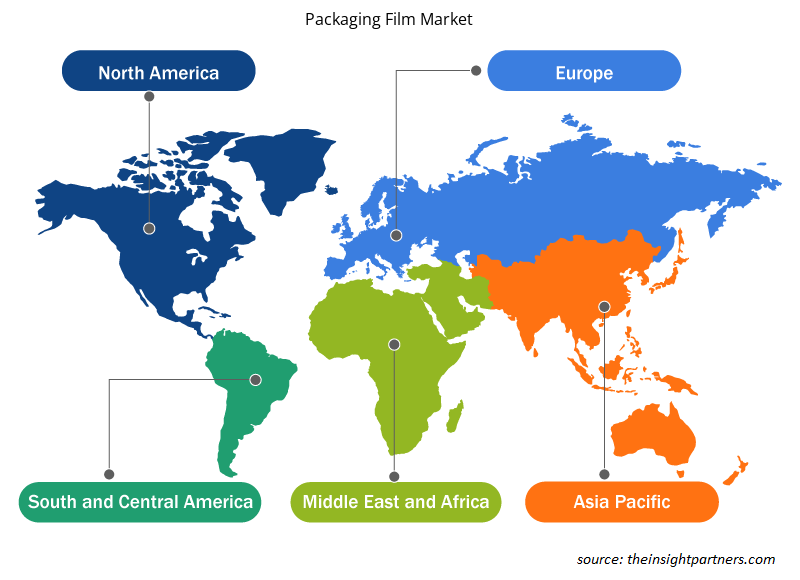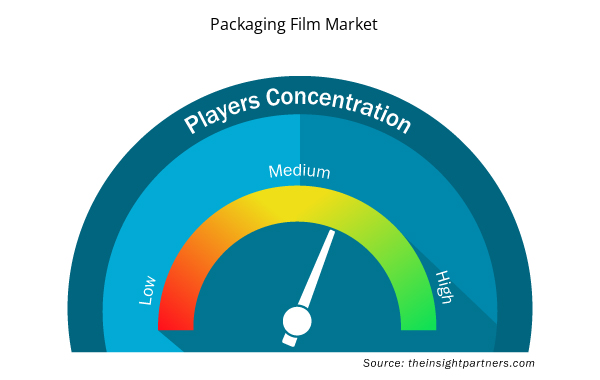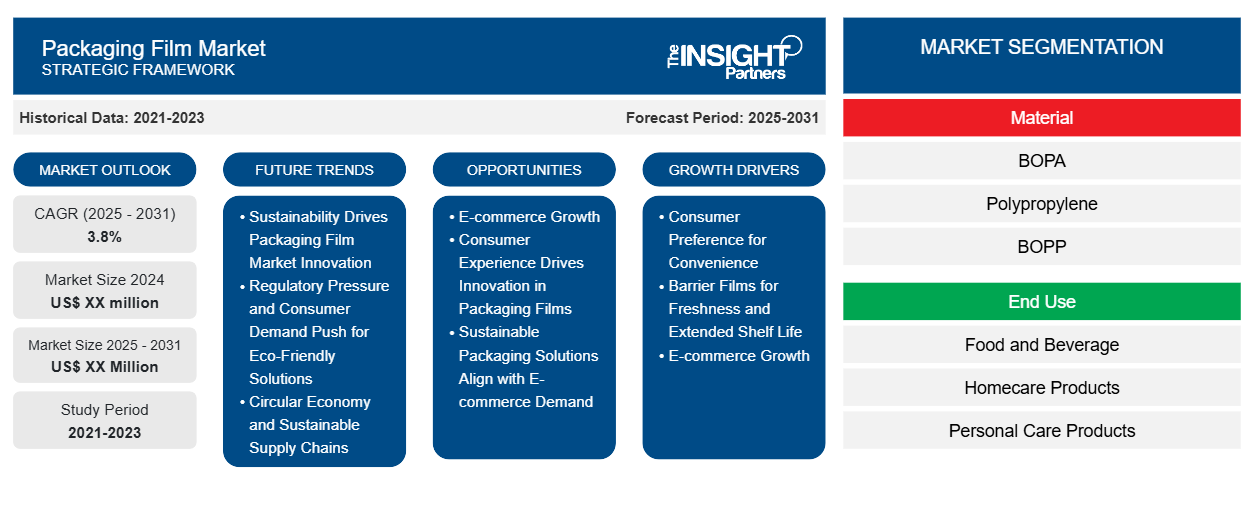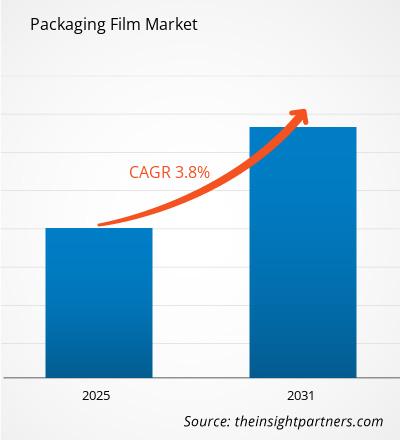Si prevede che il mercato delle pellicole per imballaggio registrerà un CAGR del 3,8% dal 2023 al 2031, con una dimensione di mercato in espansione da XX milioni di dollari nel 2023 a XX milioni di dollari entro il 2031.
Il report è segmentato per materiale (BOPA, polipropilene, BOPP, BOPET, BOPE, polietilene lineare a bassa densità, polietilene ad alta densità, PET, PVC, poliammide, EVOH e altri). Il report è inoltre segmentato in base all'uso finale (cibo e bevande, prodotti per la casa, prodotti per la cura della persona, assistenza sanitaria e farmaceutica, prodotti elettrici ed elettronici, automotive e altri). L'ambito del report copre 5 regioni: Nord America, Europa, Asia Pacifico, Medio Oriente e Africa, America meridionale e centrale e paesi chiave in ciascuna regione. L'analisi globale è ulteriormente suddivisa a livello regionale e nei principali paesi. Il report offre il valore in USD per l'analisi e i segmenti di cui sopra.
Scopo del rapporto
Il report Packaging Films Market di The Insight Partners mira a descrivere il panorama attuale e la crescita futura, i principali fattori trainanti, le sfide e le opportunità. Ciò fornirà spunti a vari stakeholder aziendali, come:
- Fornitori/produttori di tecnologia: per comprendere le dinamiche di mercato in evoluzione e conoscere le potenziali opportunità di crescita, consentendo loro di prendere decisioni strategiche informate.
- Investitori: condurre un'analisi completa delle tendenze relative al tasso di crescita del mercato, alle proiezioni finanziarie del mercato e alle opportunità esistenti lungo la catena del valore.
- Enti di regolamentazione: regolamentano le politiche e le attività di controllo sul mercato allo scopo di ridurre al minimo gli abusi, preservare la fiducia degli investitori e sostenere l'integrità e la stabilità del mercato.
Segmentazione del mercato dei film per imballaggio
Materiale
- BOPA
- Polipropilene
- BOPP
- BOPET
- BOPE
- Polietilene lineare a bassa densità
- Polietilene ad alta densità
- ANIMALE DOMESTICO
- PVC
- Poliammide
- EVOH
Uso finale
- Cibo e bevande
- Prodotti per la cura della casa
- Prodotti per la cura della persona
- Sanità e prodotti farmaceutici
- Elettrico ed elettronico
- Automobilistico
Personalizza questo report in base alle tue esigenze
Riceverai la personalizzazione gratuita di qualsiasi report, comprese parti di questo report, o analisi a livello nazionale, pacchetto dati Excel, oltre a usufruire di grandi offerte e sconti per start-up e università
- Scopri le principali tendenze di mercato in questo rapporto.Questo campione GRATUITO includerà analisi di dati che spaziano dalle tendenze di mercato alle stime e alle previsioni.
Driver di crescita del mercato dei film per imballaggio
- Preferenza del consumatore per la praticità: uno dei principali fattori trainanti della domanda di film per imballaggio è la preferenza del consumatore per la praticità. Man mano che le vite diventano più frenetiche e frenetiche, le persone cercano sempre di più pasti pronti da mangiare e qualsiasi spuntino che possano portare con sé. Ciò ha creato un'apparente tendenza per le soluzioni di imballaggio non solo per svolgere i loro compiti, ma anche per essere facili da consumare e quindi attirare la domanda di nuovi film per imballaggio.
- Film barriera per freschezza e durata di conservazione prolungata: in questo senso, gli imballaggi facili da usare spesso richiedono film barriera che facilitino il prodotto nel mantenere la freschezza e la durata di conservazione. I consumatori si aspettano che i prodotti siano sicuri e attraenti senza una preparazione estesa. Pertanto, i produttori stanno concentrando la loro attenzione sulla creazione di film di imballaggio che mostrino meglio il prodotto mentre è facile da aprire e chiudere, che è esattamente ciò che il consumatore desidera.
- Crescita dell'e-commerce: inoltre, la crescita dell'e-commerce ha aumentato considerevolmente la domanda di soluzioni di imballaggio user-friendly. La natura pratica dell'e-commerce rende più allettante la consegna diretta dei beni a domicilio dei consumatori. Situazioni come queste richiedono imballaggi che garantiscano un trasporto sicuro da un luogo all'altro e che siano comunque comodi e facili da usare. Questo cambiamento richiede ai produttori di sviluppare investimenti in tecnologie sofisticate di pellicole di imballaggio per soddisfare le mutate aspettative dei consumatori orientati alla praticità, il che a sua volta supporta la crescita del mercato.
Tendenze future del mercato dei film per imballaggio
- La sostenibilità guida l'innovazione del mercato dei film per imballaggio: la direzione attuale nei mercati dei film per imballaggio è l'uso di alternative sostenibili nei materiali. Man mano che la consapevolezza sui problemi ambientali cresce sia per i consumatori che per i produttori, aumenta la domanda di soluzioni di imballaggio con un impatto ecologico minimo. La tendenza sta spingendo i produttori a trovare materiali biodegradabili, compostabili e riciclabili per la produzione dei loro film per imballaggio.
- La pressione normativa e la domanda dei consumatori spingono verso soluzioni eco-compatibili: quindi, le pellicole soddisfano la pressione normativa e la domanda dei consumatori, risolvendo al contempo i problemi ambientali. I ricercatori hanno investito in questo settore per sviluppare pellicole che hanno prestazioni migliori e più ecologiche. È con questo in mente che prodotti innovativi, come polimeri di origine biologica e contenuti riciclati, diventano sempre più disponibili e in grado di migliorare il profilo di sostenibilità dei marchi, ottenendo al contempo una migliore possibilità di attrarre il consumatore eco-consapevole.
- Economia circolare e catene di fornitura sostenibili: il cambiamento nell'atteggiamento dell'impatto sostenibile ha un impatto anche sulla catena di fornitura, dall'acquisizione delle materie prime attraverso la catena di fornitura allo smaltimento a fine vita. I marchi sono più concentrati sulle economie circolari in cui i materiali di imballaggio vengono utilizzati, riutilizzati e riciclati. Ciò porterà alla crescita di questo mercato per i film di imballaggio poiché le aziende si sforzeranno di differenziarsi attraverso pratiche sostenibili, facendo sì che il settore nel suo complesso diventi ancora più responsabile dal punto di vista ambientale.
Opportunità di mercato per i film di imballaggio
- Crescita dell'e-commerce: la crescita dell'e-commerce costituisce la più grande opportunità nel mercato dei film per imballaggio. Man mano che sempre più persone si rivolgono allo shopping online, aumenta la necessità di soluzioni di imballaggio efficienti; tali soluzioni proteggono la sicurezza del prodotto durante il trasporto. Questa è un'enorme opportunità per i produttori di progettare film per imballaggio specifici, in particolare per l'e-commerce.
- L'esperienza del consumatore guida l'innovazione nei film per imballaggio: questo film dovrebbe essere in grado non solo di proteggere i prodotti, ma anche di contribuire positivamente all'unboxing per i consumatori, offrendo chiarezza nel vedere il prodotto, durevolezza nella gestione e facile apertura. Pertanto, le aziende possono capitalizzare tale opportunità con innovazioni nei film per imballaggio in grado di soddisfare esigenze specifiche, attraendo quindi il business dell'e-commerce alla ricerca di una soluzione affidabile.
- Soluzioni di imballaggio sostenibili in linea con la domanda di e-commerce: con l'ulteriore crescita dell'e-commerce, aumenta anche la domanda di imballaggi sostenibili. Man mano che l'ambientalismo cresce nelle menti dei consumatori, sempre più persone preferiscono pellicole per imballaggio realizzate con materiali riciclabili o biodegradabili. Ciò amplia la portata in quanto il produttore può offrire una soluzione più ecologica a chi è in concorrenza in base ai valori dei consumatori, conquistando quindi una quota di mercato più ampia.
Approfondimenti regionali sul mercato dei film per imballaggio
Le tendenze regionali e i fattori che influenzano il mercato dei film per imballaggio durante il periodo di previsione sono stati ampiamente spiegati dagli analisti di Insight Partners. Questa sezione discute anche i segmenti e la geografia del mercato dei film per imballaggio in Nord America, Europa, Asia Pacifico, Medio Oriente e Africa e Sud e Centro America.

- Ottieni i dati specifici regionali per il mercato dei film per imballaggio
Ambito del rapporto sul mercato dei film per imballaggio
| Attributo del report | Dettagli |
|---|---|
| Dimensioni del mercato nel 2023 | XX milioni di dollari USA |
| Dimensioni del mercato entro il 2031 | XX milioni di dollari USA |
| CAGR globale (2023-2031) | 3,8% |
| Dati storici | 2021-2022 |
| Periodo di previsione | 2024-2031 |
| Segmenti coperti | Per materiale
|
| Regioni e Paesi coperti | America del Nord
|
| Leader di mercato e profili aziendali chiave |
|
Densità degli attori del mercato dei film per imballaggio: comprendere il suo impatto sulle dinamiche aziendali
Il mercato del Packaging Film Market sta crescendo rapidamente, spinto dalla crescente domanda degli utenti finali dovuta a fattori quali l'evoluzione delle preferenze dei consumatori, i progressi tecnologici e una maggiore consapevolezza dei vantaggi del prodotto. Con l'aumento della domanda, le aziende stanno ampliando le loro offerte, innovando per soddisfare le esigenze dei consumatori e capitalizzando sulle tendenze emergenti, il che alimenta ulteriormente la crescita del mercato.
La densità degli operatori di mercato si riferisce alla distribuzione di aziende o società che operano in un particolare mercato o settore. Indica quanti concorrenti (operatori di mercato) sono presenti in un dato spazio di mercato in relazione alle sue dimensioni o al valore di mercato totale.
Le principali aziende che operano nel mercato dei film per imballaggio sono:
- AEP Industries Inc
- Amcor limitata
- Società per azioni Ampac, LLC
- Azienda Bemis
- Società di plastica Berry
Disclaimer : le aziende elencate sopra non sono classificate secondo un ordine particolare.

- Ottieni una panoramica dei principali attori del mercato dei film per imballaggio
Punti di forza chiave
- Copertura completa: il rapporto affronta in modo completo l'analisi di prodotti, servizi, tipologie e utenti finali del mercato delle pellicole per imballaggio, fornendo una panoramica olistica.
- Analisi degli esperti: il rapporto è compilato sulla base della conoscenza approfondita di esperti e analisti del settore.
- Informazioni aggiornate: il rapporto garantisce la pertinenza aziendale grazie alla copertura di informazioni recenti e tendenze nei dati.
- Opzioni di personalizzazione: questo report può essere personalizzato per soddisfare le esigenze specifiche del cliente e adattarsi in modo appropriato alle strategie aziendali.
Il rapporto di ricerca sul mercato dei film per imballaggio può, quindi, aiutare a guidare il percorso di decodifica e comprensione dello scenario del settore e delle prospettive di crescita. Sebbene possano esserci alcune preoccupazioni valide, i vantaggi complessivi di questo rapporto tendono a superare gli svantaggi.
- Analisi storica (2 anni), anno base, previsione (7 anni) con CAGR
- Analisi PEST e SWOT
- Valore/volume delle dimensioni del mercato - Globale, regionale, nazionale
- Industria e panorama competitivo
- Set di dati Excel



Report Coverage
Revenue forecast, Company Analysis, Industry landscape, Growth factors, and Trends

Segment Covered
This text is related
to segments covered.

Regional Scope
North America, Europe, Asia Pacific, Middle East & Africa, South & Central America

Country Scope
This text is related
to country scope.
Domande frequenti
Based on geography, Asia Pacific is expected to register the fastest CAGR from 2023 to 2031.
The report can be delivered in PDF/Word format, we can also share excel data sheet based on request.
Shift Towards sustainable materials is one of the key opportunities for the market growth.
Mondi Group, Kureha Corporation, Berry Global Inc, Toray Industries Inc, SUDPACK Holding GmbH, Amcor Plc, Sealed Air Corporation, Tagleef Industries Group, Dunmore Corporation, and Cosmo Film are among the leading players operating in the packaging films market.
Expansion into emerging markets is driving the market growth
The Packaging Films Market is estimated to witness a CAGR of 3.8% from 2023 to 2031
Trends and growth analysis reports related to Chemicals and Materials : READ MORE..
1. AEP Industries Inc
2. Amcor Limited
3. Ampac Holdings, LlC
4. Bemis Company
5. Berry Plastics Corporation
6. Charter Nex Films Inc
7. Dupont Teijin Films
8. Exopack Holding Corporation
9. Graphic Packaging Holding Corporation
10. Hilex Poly Co LlC
The Insight Partners performs research in 4 major stages: Data Collection & Secondary Research, Primary Research, Data Analysis and Data Triangulation & Final Review.
- Data Collection and Secondary Research:
As a market research and consulting firm operating from a decade, we have published and advised several client across the globe. First step for any study will start with an assessment of currently available data and insights from existing reports. Further, historical and current market information is collected from Investor Presentations, Annual Reports, SEC Filings, etc., and other information related to company’s performance and market positioning are gathered from Paid Databases (Factiva, Hoovers, and Reuters) and various other publications available in public domain.
Several associations trade associates, technical forums, institutes, societies and organization are accessed to gain technical as well as market related insights through their publications such as research papers, blogs and press releases related to the studies are referred to get cues about the market. Further, white papers, journals, magazines, and other news articles published in last 3 years are scrutinized and analyzed to understand the current market trends.
- Primary Research:
The primarily interview analysis comprise of data obtained from industry participants interview and answers to survey questions gathered by in-house primary team.
For primary research, interviews are conducted with industry experts/CEOs/Marketing Managers/VPs/Subject Matter Experts from both demand and supply side to get a 360-degree view of the market. The primary team conducts several interviews based on the complexity of the markets to understand the various market trends and dynamics which makes research more credible and precise.
A typical research interview fulfils the following functions:
- Provides first-hand information on the market size, market trends, growth trends, competitive landscape, and outlook
- Validates and strengthens in-house secondary research findings
- Develops the analysis team’s expertise and market understanding
Primary research involves email interactions and telephone interviews for each market, category, segment, and sub-segment across geographies. The participants who typically take part in such a process include, but are not limited to:
- Industry participants: VPs, business development managers, market intelligence managers and national sales managers
- Outside experts: Valuation experts, research analysts and key opinion leaders specializing in the electronics and semiconductor industry.
Below is the breakup of our primary respondents by company, designation, and region:

Once we receive the confirmation from primary research sources or primary respondents, we finalize the base year market estimation and forecast the data as per the macroeconomic and microeconomic factors assessed during data collection.
- Data Analysis:
Once data is validated through both secondary as well as primary respondents, we finalize the market estimations by hypothesis formulation and factor analysis at regional and country level.
- Macro-Economic Factor Analysis:
We analyse macroeconomic indicators such the gross domestic product (GDP), increase in the demand for goods and services across industries, technological advancement, regional economic growth, governmental policies, the influence of COVID-19, PEST analysis, and other aspects. This analysis aids in setting benchmarks for various nations/regions and approximating market splits. Additionally, the general trend of the aforementioned components aid in determining the market's development possibilities.
- Country Level Data:
Various factors that are especially aligned to the country are taken into account to determine the market size for a certain area and country, including the presence of vendors, such as headquarters and offices, the country's GDP, demand patterns, and industry growth. To comprehend the market dynamics for the nation, a number of growth variables, inhibitors, application areas, and current market trends are researched. The aforementioned elements aid in determining the country's overall market's growth potential.
- Company Profile:
The “Table of Contents” is formulated by listing and analyzing more than 25 - 30 companies operating in the market ecosystem across geographies. However, we profile only 10 companies as a standard practice in our syndicate reports. These 10 companies comprise leading, emerging, and regional players. Nonetheless, our analysis is not restricted to the 10 listed companies, we also analyze other companies present in the market to develop a holistic view and understand the prevailing trends. The “Company Profiles” section in the report covers key facts, business description, products & services, financial information, SWOT analysis, and key developments. The financial information presented is extracted from the annual reports and official documents of the publicly listed companies. Upon collecting the information for the sections of respective companies, we verify them via various primary sources and then compile the data in respective company profiles. The company level information helps us in deriving the base number as well as in forecasting the market size.
- Developing Base Number:
Aggregation of sales statistics (2020-2022) and macro-economic factor, and other secondary and primary research insights are utilized to arrive at base number and related market shares for 2022. The data gaps are identified in this step and relevant market data is analyzed, collected from paid primary interviews or databases. On finalizing the base year market size, forecasts are developed on the basis of macro-economic, industry and market growth factors and company level analysis.
- Data Triangulation and Final Review:
The market findings and base year market size calculations are validated from supply as well as demand side. Demand side validations are based on macro-economic factor analysis and benchmarks for respective regions and countries. In case of supply side validations, revenues of major companies are estimated (in case not available) based on industry benchmark, approximate number of employees, product portfolio, and primary interviews revenues are gathered. Further revenue from target product/service segment is assessed to avoid overshooting of market statistics. In case of heavy deviations between supply and demand side values, all thes steps are repeated to achieve synchronization.
We follow an iterative model, wherein we share our research findings with Subject Matter Experts (SME’s) and Key Opinion Leaders (KOLs) until consensus view of the market is not formulated – this model negates any drastic deviation in the opinions of experts. Only validated and universally acceptable research findings are quoted in our reports.
We have important check points that we use to validate our research findings – which we call – data triangulation, where we validate the information, we generate from secondary sources with primary interviews and then we re-validate with our internal data bases and Subject matter experts. This comprehensive model enables us to deliver high quality, reliable data in shortest possible time.


 Ottieni un campione gratuito per questo repot
Ottieni un campione gratuito per questo repot